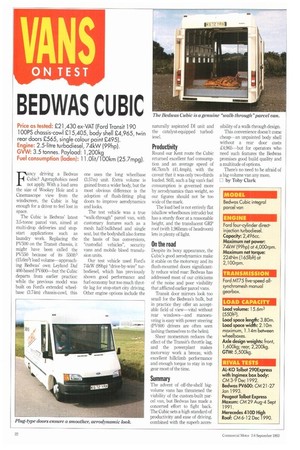BED WAS CUBIC
Page 26

If you've noticed an error in this article please click here to report it so we can fix it.
Price as tested: £21,430 ex-VAT (Ford Transit 190 100PS chassis-cowl £15,405, body shell £4,965, twin rear doors £565, single colour paint £495). Engine 2.5-litre turbodiesel, 74kW (99hp). GVW: 3.5 tonnes. Payload: 1,200k9 Fuel consumption (laden): 11.01it/100km (25.7mpg).
Fancy driving a Bedwas Cubic? Agoraphobics need not apply. With a load area the size of Wookey Hole and a Cinemascope view from the windscreen, the Cubic is big enough for a driver to feel lost in space.
The Cubic is Bedwas' latest 3.5-tonne parcel van, aimed at multi-drop deliveries and stopstart applications such as laundry work. Replacing the PV500 on the Transit chassis, it might have been called the PV550 because of its 550ft3 (15.6m3) load volume—approaching Bedwas' own Leyland Daf 400-based PV600—but the Cubic departs from earlier practice: while the previous model was built on Ford's extended wheelbase (3.74m) chassis-cowl, this
one uses the long wheelbase (3.57m) unit. Extra volume is gained from a wider body, but the most obvious difference is the adoption of flush-fitting plug doors to improve aerodynamics and looks.
The test vehicle was a true "walk-through" parcel van, with customary features such as a mesh half-bulkhead and single seat, but the bodyshell also forms the basis of bus conversions, "custodial vehicles", security vans and mobile blood transfusion units.
Our test vehicle used Ford's 74kW (99hp) "drive-by-wire" turbodiesel, which has previously shown good performance and fuel economy but too much throttle lag for stop-start city driving. Other engine options include the naturally aspirated DI unit and the catalyst-equipped turbodiesel.
Productivity
Round our Kent route the Cubic returned excellent fuel consumption and an average speed of 66.7km/h (41.4mph), with the caveat that it was only two-thirds loaded. Still, such a big van's fuel consumption is governed more by aerodynamics than weight, so our figures should not be too wide of the mark.
The load bed is not entirely flat (shallow wheelboxes intrude) but has a sturdy floor at a reasonable height, and the translucent GRP roof (with 1,965mm of headroom) lets in plenty of light.
On the road Despite its boxy appearance, the Cubic's good aerodynamics make it stable on the motorway and its flush-mounted doors significantly reduce wind roar: Bedwas has addressed most of our criticisms of the noise and poor visibility that afflicted earlier parcel vans.
Transit door mirrors look too small for the Bedwas's bulk, but in practice they offer an acceptable field of view—vital without
rear windows and manoeuvring is easy with power steering (PV600 drivers are often seen lashing themselves to the helm).
Sheer momentum reduces the effect of the Transit's throttle lag, and the powerplant makes motorway work a breeze, with excellent hillclimb performance and enough torque to stay in top gear most of the time.
Summary
The advent of off-the-shelf bigvolume vans has threatened the viability of the custom-built parcel van, but Bedwas has made a concerted effort to fight back. The Cubic sets a high standard of productivity and ease of driving, combined with the superb acces
sibility of a walk-through design.
This convenience doesn't come cheap—an unpainted body shell without a rear door costs £4,965—but for operators who need such features the Bedwas promises good build quality and a multitude of options.
There's no need to be afraid of a big-volume van any more.
El by Toby Clark












































































































